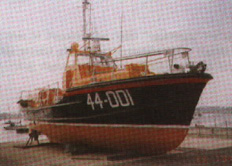|
The
Waveney Class of Lifeboat
|
 |
The Waveney Class of Lifeboat was built at Brookes Marine in Suffolk, England. The Waveney River passes through the County of Suffolk and enters the sea at Lowestoft on the east coast of England. The hull of this 44' Waveney Class lifeboat is built in "Cor-ten" corrosion resistent steel. The raised fore deck, raised aft deck and midships deck, together with the superstructure are made of marine grade aluminium, to reduce weight. This construction also serves to lower thecentre of gravity of the lifeboat and thus improve her self-righting capabilities. It was based on a design by LCDR R.W. Witter of the US Coast Guard. Waveney Sketch
Fixed trim tabs are fitted either side of the centre line under the stern, below the waterline and extend just aft of the twin screws. The twin rudders are streamlined semi-balanced types, fabricated from Cor-ten steel shaped plates. The Waveney is powered by twin Caterpillar 3208NA diesel, 4 stroke, 8 cylinder engines, which idle at 650 rpm. There is an auxiliary generator set in the engine room also. All three units are totally independent with their own water cooling, sea water cooling, fuel, exhaust system and controls. The lifeboat carries 2 x 500 ltrs of diesel in the mains and a 340 ltr reserve tank - a total of 1340 litres of diesel. An electro-magnetic clutch operated firemain pump is mounted on the forward end of the port engine and is belt driven. It draws water from its own sea inlet and supplies water under pressure to a deck hydrant on the port side. A three - way cock allows emergency bilge suction to be connected, if needed. The electrical system is a 24 volt DC, two wired insulated return system with double pole circuit breaker switches. Two banks of batteries provide reserve of power and are charged by main engine driven alternators, an auxiliary generator or from an external supply. The batteries aresited below the deck of the crew/radio cabin. The "H" aerial on top of the mast is the directional aerial for the VHF D/F outfit. The VHF dipole for the VHF is on the front side of the mast located about half way down its length. The MF whip aerials, port and starboard sides of the superstructure are folding types. The port whip is for the Decca Navigator outfit and the starboard whip is for the MF transceiver. The crossed loop aerial on the top of the wheelhouse is the aerial for the MF automatic D/F outfit. The radar aerial is fitted on an extension fitted to the wheelhouse roof. Deck Sketch The mast also bears a white masthead steaming light, a towing light and a stern light along with a blue flashing light. In addition a searchlight is fitted. Lifeboat Sketch
|